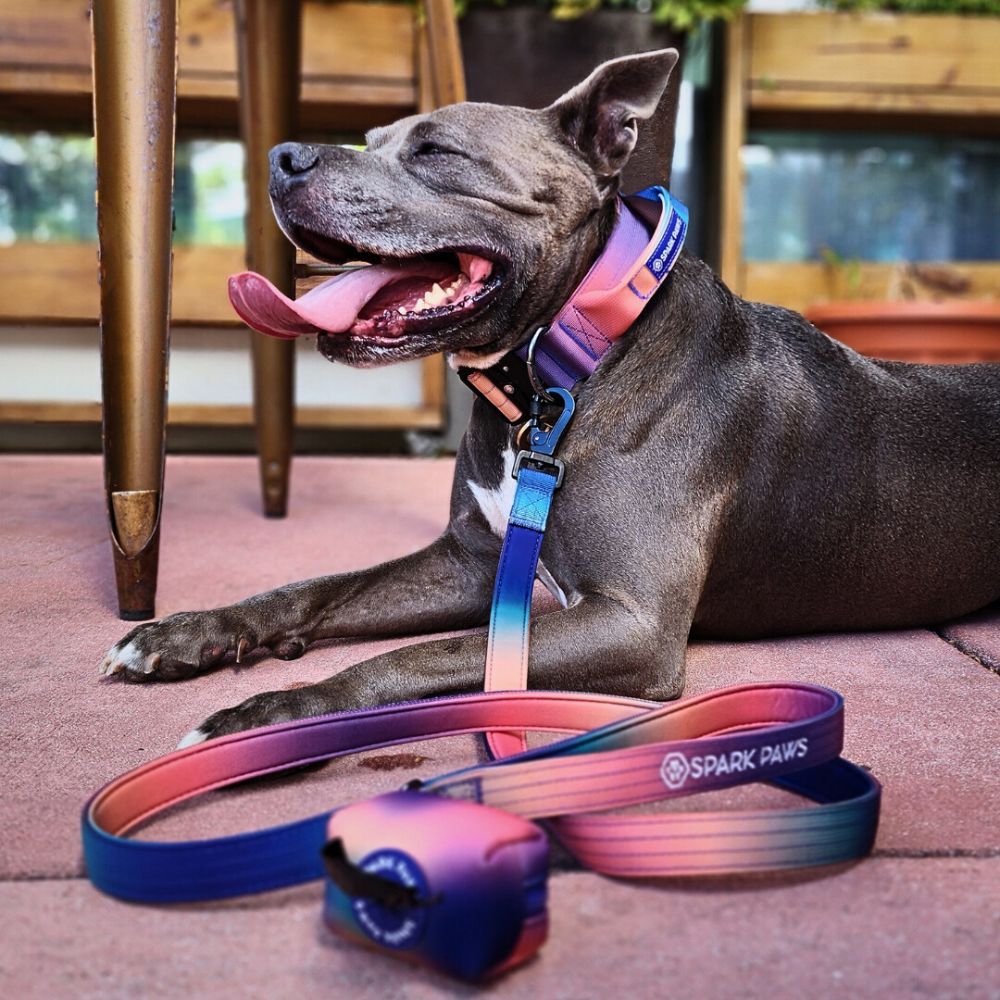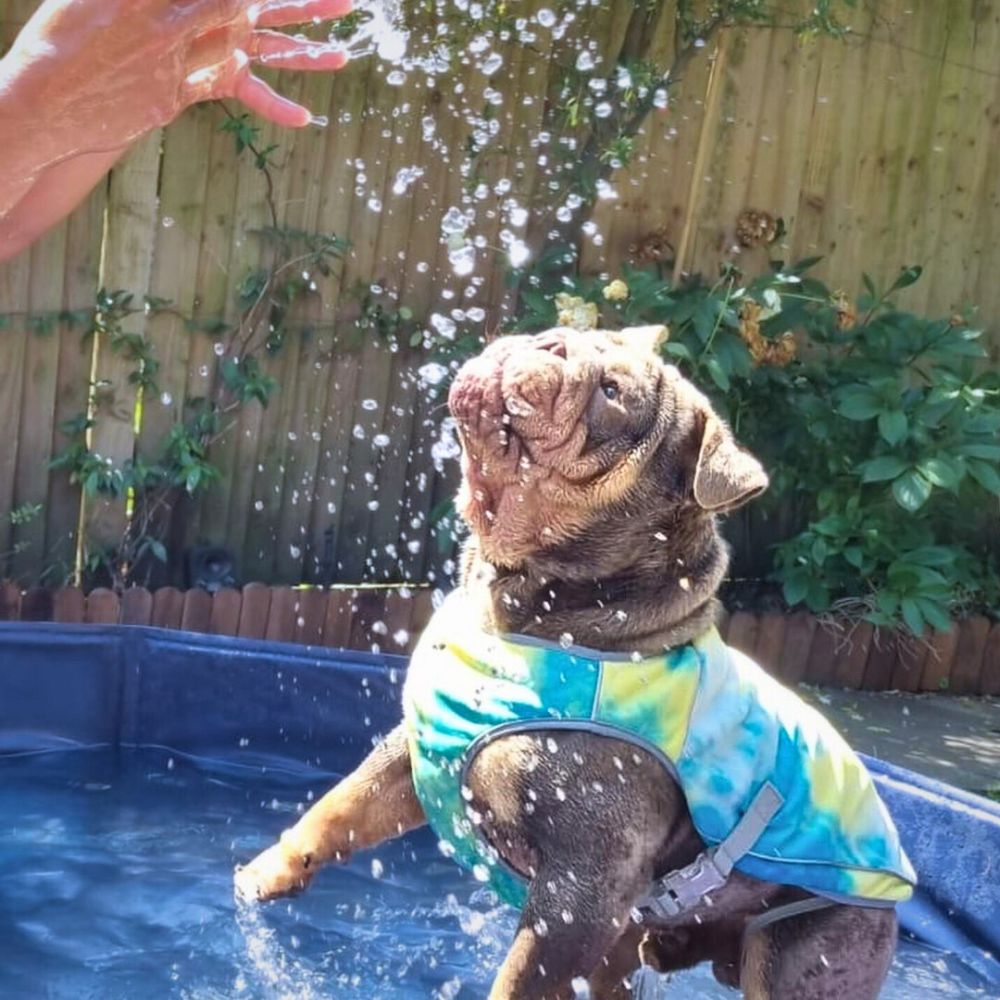When Is It Too Hot To Walk Your Dog
With summer around the corner and temperatures beginning to creep up, you may start to worry about the hot summer months. While most dogs don’t mind a bit of hot weather, there is a limit to how much they can take.
You may wonder - How hot is too hot for my dog? How do I know if they are doing ok? What steps can I take to make them comfortable and minimize the risks?

Sparkpaws No-pull Harness Kaleidoscope
Hot Air
The biggest risks of hot weather are heat stroke and heat exhaustion. This can happen quite quickly, even in seemingly low temperatures. Your dog’s body temperature is naturally warmer than ours and they cannot sweat, so they’re more likely to feel the heat before we do.
The general rule of temperature is that anything over 89℉ (31℃) is too hot for your dog to be outside for any extended period of time. An air temperature of 80+℉ (26+℃) can be considered a ‘high risk’ temperature, with some breeds being even lower. There isn’t much risk below 75℉ (24℃) unless your dog has special needs.
High humidity can also quickly lead to heat stroke and may make hot weather feel even hotter than it should. A general rule of thumb is that the humidity plus temperature (in Fahrenheit) should not exceed 150. For example - An air temperature of 83℉ + 70% humidity = 153, which is too hot to walk safely.
Hot Pavement and Sand
Surfaces such as pavement, sand, and decking can quickly become scorching in hot, sunny weather.
Dog paw pads are tougher than human feet, but your dog’s paws can easily burn on hot pavement and asphalt. This can be extremely uncomfortable for the dog, cause cracking and pain, and even lead to the need for expensive and unpleasant medical intervention.
Damage can happen in less than sixty seconds, especially on delicate puppy paws or dogs that have injured or scarred paw pads.
To test if a surface is a safe temperature for your dog’s paws, you should be able to press your hand to the surface and comfortably hold it there for around 10 seconds. If it's too hot for human hands then it's too hot for dog paws.
However, this isn't necessarily a deal breaker, since you may be able to protect your dog’s paw pads with a pair of doggy shoes. Just be careful with breeds that sit very low to the ground, as the hot air can radiate from the pavement and overheat them.

High-Risk Dogs…
Naturally, some dogs are going to have a harder time than others when it comes to heat.[1] These dogs may need to be watched carefully or have extra cautionary measures in place to prevent heatstroke.
Age
Both Senior dogs and puppies may have a harder time regulating their body temperatures. Young dogs may also have a lot of energy and overexert themselves in warmer temperatures without realizing it. Older dogs may move slower and be exposed to sun and hot pavement temperatures for longer.
Coat Thickness
Dogs with thicker coats are naturally more prone to overheating and heat stroke than short-haired breeds. However, breeds with very short coats, such as pit bulls, may be at risk of sunburn.
Dogs with darker coats may also absorb more heat than dogs with lighter coats.
General Health
Some health conditions may negatively impact your dog’s ability to dissipate heat and stay cool. Other conditions, such as heart disease, may make the dog more vulnerable to heat as well. Always consult a vet if your dog suffers from a diagnosed or suspected chronic condition.
Size
Smaller dogs have an easier time getting rid of extra built-up heat than big dogs, though their smaller size can also put them at risk if walking in a very built-up area - as radiated heat from surfaces may reach them easier than big dogs.
Overweight dogs may also have a harder time staying cool and dispelling heat. The more overweight, the greater the risk. Obese dogs are some of the most common sufferers of heat-related illness. [2]
Breed
Flat-faced (Brachycephalic) dogs, such as pugs, may struggle to pant normally. Panting is a dog’s main way of staying cool, which puts these dogs at higher risk.
Signs of Heat Stroke in Dogs
Early signs of heat stroke include -
- Panting and drooling
- Red gums
- Vomiting
- Fast heartbeat
More advanced symptoms can include -
- Weakness and lethargy
- Fainting
- Seizures
This is a medical emergency and your dog will need to see a vet. Even if they start to improve, they will still need to be looked over.
First Aid
If you are far from a vet or scared to move your dog, you can try these methods to cool them down so that you can transport them.
- Keep the dog cool by moving it indoors or to a shady area
- Reduce body temperature by pouring cool (NOT ice cold!) water over their bodies
- Offer them water but don’t force them to drink
- Apply a cold pack wrapped in a towel to their stomach and neck
- Call your vet and follow their further instructions
What Do I Do If It's Too Hot Out?
Safer Walks
If it isn't extremely hot outside and you don’t have a particularly ‘at risk’ dog, you may still be able to do some of your regular exercise schedule. However, you can make it safer by choosing to exercise in the early morning or evening, when temperatures aren’t as extreme.You can also prevent your dog from overheating by making sure they have access to cool water and that their coats are brushed out from any excess fluff.
You can also include summer accessories, such as light-colored cooling vests or shoes, to protect your dog from the worst of the sun on hot days.
Alternative Exercise
There’s still lots of fun to be had on hot days. If you like having your dog outdoors, you could try taking them to a beach or lake (Provided they’re actually going to swim) or even set up your own kiddie pool or hose/sprinkler system in the backyard.
Otherwise, you may try some indoor exercises such as tug-of-war. Mentally stimulating games such as hide and seek with food, toys, fetch, or even learning new tricks will prevent them from becoming too bored on hot days.[2]
If your house is large enough, you can also try more challenging exercises such as playing fetch in the hall or running your dog up and down the stairs.[3]
Conclusion
‘How hot is too hot?’ is not a straightforward question, however, temperatures over 89℉ (31℃) are generally considered as being too hot to take your dog outside. Temperatures between 89℉ (31℃) and 75℉ (24℃) can be considered ‘risky’. Humidity can also cause temperatures to be hotter than predicted.
Owners should also be concerned about surface temperatures, as hot concrete and sand can quickly cause burns and discomfort. You should always test a risky surface with your hand before letting your dog go on it bare-pawed.
Age, general health, breed, and size can also determine how much heat a dog can take before it becomes dangerous. An owner should carefully monitor their dog’s condition, especially in a mixed pack.
Signs of heat stroke can include panting, vomiting, and fainting. Try and cool the dog off immediately, but they should also see a vet, even if they start to improve.
The risks can be minimized by sticking to indoor activities or choosing areas where the dog can stay cool by swimming.
Otherwise, certain accessories can also help. Dog shoes can greatly reduce the risk of fried paw pads, and light-colored cooling vests can help deflect some of those harsh rays and keep your pet at a comfortable temperature.
If you would like to check out some of these options, have a browse through Sparkpaws’ Cooling Vest collection or our Dog Shoes and Boots Collection for products that will keep your furry friend safe and comfortable on hot days.
Happy Walking!
Ext links
[1] https://www.rvc.ac.uk
[2] https://www.diamondpet.com
[3] https://spca.bc.ca
[4] https://pupford.com
